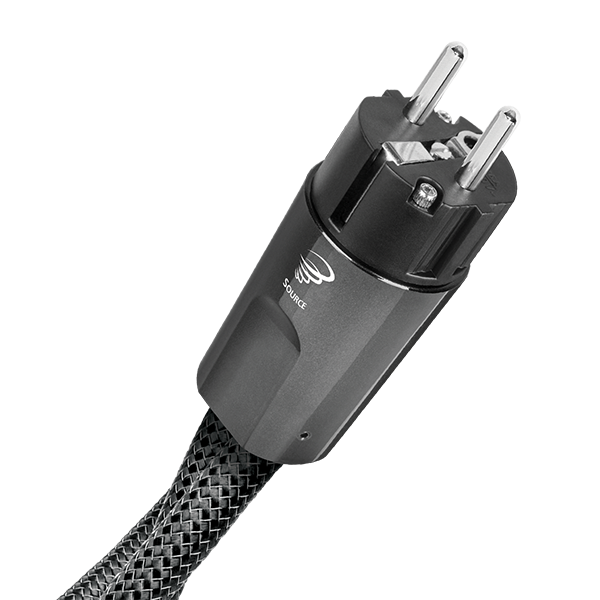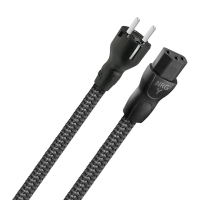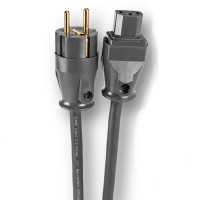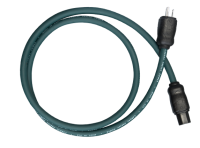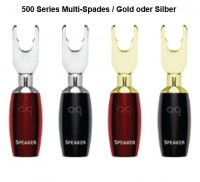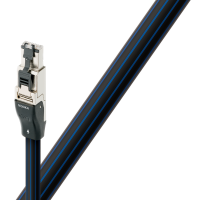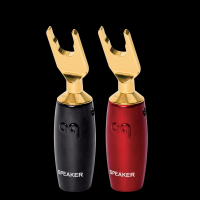- Artikel-Nr.: JH-24706
- EAN: 0092592099814
Audioquest Tornado Source
3-poliges Netzkabel mit niedriger Impedanz und Noise Dissipation
- Massive Leiter aus Perfect-Surface Copper+ (PSC+) und Perfect-Surface Copper (PSC)
- Für Quellkomponenten optimiert
- Ableitung von Erdungsstörungen (US Patent Nr. 9,373,439)
- ZERO (kein) Wellenwiderstand (50 Hz – 1 MHz)
- 72-V-Gleichstrom-Dielectric-Bias-System (US Patent Nr. 7,126,055)
- Laufrichtungsgebundene Leiter
Wechselstrom (AC) ist alles andere als die perfekte Stromquelle. Die Wechselstrom-Technologie ist mehr als hundert Jahre alt und war nie dafür gedacht, die Anforderungen aktueller hochauflösender Audio/Video-Komponenten zu erfüllen. Wechselstromrauschen stammt aus der Stromquelle, wird durch vom Netzkabel aufgenommenes Hochfrequenzrauschen verstärkt und gelangt an die Netzteile der Komponenten und an die Masse des Schaltkreises. Dies erzeugt Verzerrungen und durch den „Maskierungseffekt“ Signalverluste bei niedrigen Pegeln. Die meisten Netzkabel, Power-Conditioner-Regeneratoren bringen zwar in einem gewissen Maße eine Verbesserung, sind aber letztlich der Aufgabe nicht gewachsen.
Hinweis: Das Netzkabel AudioQuest Tornado/Source ist nicht für den Gebrauch mit Netzstromaufbereitern, Netzstromregeneratoren, AC-Trenntrafos, AC-Batterie-Notstromgeräten geeignet, ebenso wenig für Leistungsverstärker, Aktivsubwoofer, Aktivlautsprecher, AV-Receiver oder Vollverstärker (unabhängig davon, ob Röhre, Transistor oder Digitalschaltung). Diese Produkte benötigen größere RMS- und Stromspitzenkapazitäten. In extremen Fällen können Leistungseinbußen auftreten und/oder die Geräte bei Überschreiten der maximalen Stromlieferfähigkeit des AudioQuest-Tornado/Source-Netzkabels eine eine elektrische Gefahr darstellen. Für solche Anwendungen empfehlen wir den Gebrauch des Kabels AudioQuest Tornado High (Variable) Current.
HOCHREINE LEITER – PERFECT-SURFACE COPPER (PSC) UND PERFECT-SURFACE COPPER+ (PSC+)
Im Tornado/High-Current kommt eine sorgfältig abgestimmte Zusammenstellung von eindrähtigen Leitern aus Perfect-Surface Copper (PSC) und extrem hochreinem Perfect-Surface Copper+ (PSC+) zum Einsatz, die das gegenseitige Beeinflussen einzelner Litzen und somit eine Hauptursache für transiente Intermodulationsverzerrungen verhindert, die zu Hör-Ermüdung führen. Das erstaunlich glatte und reine Perfect-Surface Copper eliminiert Rauheiten und verbessert im Vergleich zu OFHC, OCC, 8N und anderen Premiumkupfern die Transparenz deutlich. Die außergewöhnliche Reinheit von PSC+ verringert außerdem Verzerrungen, welche aufgrund der in jedem Metallleiter vorhandenen Konrgrenzen entstehen.
GROUND-NOISE-DISSIPATION-TECHNOLOGIE
Masseleiter an Netzkabeln bieten Schutz vor den Mängeln der Netzverkabelung, aber sie fungieren gleichzeitig als Antennen. Deshalb unterliegen sie dem Einfluss von Hochfrequenzrauschen (HF). Dieses HF-Rauschen umgeht die Komponentennetzteile und wird üblicherweise direkt an die empfindlichsten AV-Schaltungen eines Systems weitergeleitet. Die patentierte Ground-Noise Dissipation (Ableitung von Erdungsstörungen) von AudioQuest verringert in hohem Maße Verzerrungen und liefert ein bisher nicht gekanntes Maß an Rauschableitung über die größtmögliche Hochfrequenzbandbreite. In unserer einzigartigen Schaltungstopologie kommt eine Anordnung zur Gleichtakt-Phasenauslöschung im Verbund mit proprietären dielektrischen Materialien zum Einsatz, die eine zusätzliche lineare Differenzial-Filterung bewirken. (US Patent Nr. 9,373,439)
DIELECTRIC-BIAS-SYSTEM MIT HOCHFREQUENZ-RAUSCHFALLE
Die Isolierung zwischen zwei oder mehr Leitern ist ein Dielektrikum, dessen Eigenschaften die Unversehrtheit des Signals beeinträchtigen. Hat das Dielektrikum keine Vorspannung, verursacht die Beteiligung des Dielektrikums (Absorption und nichtlineare Freisetzung von Energie) für verschiedene Frequenzen und Energielevels unterschiedliche Zeitverzögerungen (Phasenverschiebung), was für sehr zeitkritisches Mehroktaven-Audio ein großes Problem darstellt. Mit der Einbindung einer HF-Falle (ursprüngich für die AudioQuest-Stromprodukte der Niagara-Serie entwickelt) wird sichergestellt, dass kein Hochfrequenzrauschen von den DBS-Feldelementen in die Signalleiter gelangt. (DBS, US-Patentnummern 7,126,055 & 7,872,195 B1)
DIREKTIONALITÄT
Alle gezogenen Metallitzen und -leiter weisen eine asymmetrische und deshalb laufrichtungsgebundene Kornstruktur auf. Die daraus resultierenden wechselnden HF-Impedanzen werden von AudioQuest so gesteuert, dass das Rauschen von dort, wo es Verzerrungen verursachen würde, weggeleitet wird. Die korrekte Laufrichtung wird ermittelt, indem jede Charge an Metallleitern in jedem AudioQuest-Audiokabel einem Hörtest unterzogen wird. Dort, wo die Laufrichtung eine Rolle spielt, sind die Stecker deutlich mit entsprechenden Pfeilen gekennzeichnet, um die überragende Klangqualität sicherzustellen. Bei den meisten AQ-Kabelmodellen geben die Pfeile nicht nur die Richtung an, bei welcher im Rahmen der Rauschableitung die Metall-Laufrichtung optimal genutzt wird, sondern verweist auch auf die unsymmetrische Anordnung von Schirmung und GND, um die Leistung des gesamten Systems zu optimieren.
Das Unternehmen Audioquest wurde im Jahr 1980 von William E. Low in einer Garage gegründet. Kaum vorstellbar, denn heute gehört Audioquest zu einer der weltweit berühmtesten Kabelhersteller. Der Erfolg in Deutschland setzte aber erst im Jahr 2003 richtig ein. Nachdem die Distribution von Audioquest erst über Marantz und später über Screen Professional erfolgte. Doch was ist das besondere an diesem Kabelhersteller?
Der Gründer William Löw und seine kompetenten Ingenieure haben die Lötverbindung an der Verbindung Stecker/Kabel als einen Schwachpunkt entdeckt. Als Konsequenz daraus, entschied sich das Unternehmen eine eigene Lötlegierung zu entwickeln. Ein spezielles Lötverfahren stellt nun sicher, dass auf der gesamten Frequenzbandbreite kein geringer Zwischenton verloren geht oder verfälscht wird. Für die Signalleiter verwendet Audioquest ein selbstentwickeltes Kupfer, mit einer längs zur Signalaufrichtung geordneten Molekularstruktur.
Diese Neuheiten haben sich besonders im Bereich der tieffrequenz-strapazierten Subwooferkabel bewährt. Besonders Musikliebhaber in den USA und in England wissen diese hohe Qualität zu schätzen und können sich keinen anderen Hersteller in diesem Bereich mehr vorstellen.







